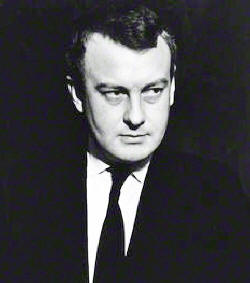

Queer Places:
Whitechapel Art Gallery, 77-82 Whitechapel High St, London E1 7QX, UK
 Bryan Robertson OBE (1 April 1925 – 18 November 2002) was an English curator and arts manager described by Studio International as "the greatest Director the Tate Gallery never had".[1]
Bryan Robertson OBE (1 April 1925 – 18 November 2002) was an English curator and arts manager described by Studio International as "the greatest Director the Tate Gallery never had".[1]
Robertson was born in London and educated at Battersea Grammar School.[2] Unfit for military service, he became a junior editor on The Studio magazine in 1945.[2] The art-historian and curator Kenneth Clark became a mentor, funding a year in Paris for study.[2] In 1949 Robertson became curator at the Heffer Gallery in Cambridge and mounted a ground-breaking exhibition of contemporary French art at the Fitzwilliam Museum.[2]
In 1952 Bryan Robertson becomes the Director of the Whitechapel Art Gallery. A run down gallery with the air of a provincial backwater, he transformed it into a light, white modernist space and instigated a series of ground breaking shows. From the first retrospective of Turner since his death to re-invigorating interest in Barbara Hepworth. ‘This Is Tomorrow’, the first Pop art show anywhere included Richard Hamilton whose collage ’Just What is It That Makes Today’s Homes So Different, So Appealing?’ that includes a physique muscle man. The Whitechapel ‘New Generation’ exhibitions invigorated the reception of modern British art. As junior sub-editor on the The Studio he reviewed exhibitions of the work of many of the ‘Neo-Romantic’ artists and became friends with the younger generation eventually giving them retrospectives. These included John Craxton (1967), Prunella Clough, the ‘two Roberts’, Colquhoun (1958) and MacBryde, and John Minton. They all featured in retrospectives at the Whitechapel, along with other pivotal figures such as Roy Le Maistre (1960), Robert Medley (1963) and Keith Vaughan (1962), the later particularly significant for the inclusion of so many patently gay themed works. Between 1958 and 1964 he put on ground breaking shows of Abstract Expressionists with exhibitions including gay artists Mark Tobey (1962), Robert Rauschenberg and Jasper Johns. A disagreeable relationship between him and the critic David Sylvester was the result of Sylvester failing to get the job. A similar messy bid to become Tate Director between him and Laurence Gowing resulted in appointment of the entirely dull Norman Reid. Robertson said his philosophy was ‘a life-long concern for pleasure, beautiful places, good-looking people, and frivolous living.’
Robertson was key in promoting the careers of many emerging British artists; Anthony Caro, David Hockney, John Hoyland,[8] Bridget Riley, William G. Tucker, and Phillip King.[4][6] Robertson placed public education at the heart of the Whitechapel programme giving space to exhibitions of work from schools.[6] Robertson's period at the Whitechapel transformed the profile of the Gallery at a time when it did not have regular funding from the Arts Council of Great Britain,[2] and he was regarded as a frontrunner to take over at the Tate Gallery in 1964[9] following the retirement of John Rothenstein but due to politics lost out to the Gallery's deputy director, Norman Reid.[6] He became director of the museum of the State University of New York for five years and wrote articles and monographs.[4] Robertson sat on the Arts Council art committee between 1958 and 1961 and again from 1980 to 1984.[4] During his second term he began working as a freelance curator and built an impressive roster of noteworthy exhibitions, including the magnificent Raoul Dufy show at the Hayward Gallery (1983), an important retrospective of Ceri Richards at the Tate[2] as well as co-curating Flowers Gallery's 1994 exhibition British Abstract Art Part 1: Painting[10] at Flowers East and Flowers East at London Fields.
My published books: